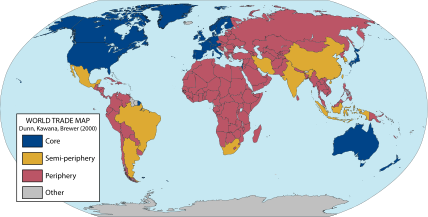
Back نظرية المنظومات العالمية Arabic Teoria del sistema-món Catalan Teorie světového systému Czech Weltsystem-Theorie German Sistema-mundo Spanish نظریه نظامهای جهانی Persian Système-monde French वैश्विक प्रणाली Hindi Աշխարհահամակարգերի տեսություն Armenian Teori sistem dunia ID
This article needs additional citations for verification. (March 2023) |


| Part of a series about |
| Imperialism studies |
|---|
 |
World-systems theory (also known as world-systems analysis or the world-systems perspective)[3] is a multidisciplinary approach to world history and social change which emphasizes the world-system (and not nation states) as the primary (but not exclusive) unit of social analysis.[3]
"World-system" refers to the inter-regional and transnational division of labor, which divides the world into core countries, semi-periphery countries, and the periphery countries.[4] Core countries have higher-skill, capital-intensive industries, and the rest of the world has low-skill, labor-intensive industries and extraction of raw materials.[5] This constantly reinforces the dominance of the core countries.[5] Nonetheless, the system has dynamic characteristics, in part as a result of revolutions in transport technology, and individual states can gain or lose their core (semi-periphery, periphery) status over time.[5] This structure is unified by the division of labour. It is a world-economy rooted in a capitalist economy.[6] For a time, certain countries become the world hegemon; during the last few centuries, as the world-system has extended geographically and intensified economically, this status has passed from the Netherlands, to the United Kingdom and (most recently) to the United States.[5]
Components of the world-systems analysis are longue durée by Fernand Braudel, "development of underdevelopment" by Gunder Frank, and the single-society assumption.[7] Longue durée is the concept of the gradual change through the day-to-day activities by which social systems are continually reproduced.[7] "Development of underdevelopment" described that the economic processes in the periphery are the opposite of the development in the core. Poorer countries are impoverished to enable a few countries to get richer.[7] Lastly, the single-society assumption opposes the multiple-society assumption and includes looking at the world as a whole.[7]
World-systems theory has been examined by many political theorists and sociologists to explain the reasons for the rise and fall of states, income inequality, social unrest, and imperialism.
- ^ Chase-Dunn, Christopher; Kawano, Yukio; Brewer, Benjamin D. (2000). "Trade Globalization since 1795: Waves of Integration in the World-System". American Sociological Review. 65 (1): 77–95. doi:10.2307/2657290. ISSN 0003-1224. JSTOR 2657290. S2CID 147609071. See appendix with the country list ("Table A2"). Some countries with a population of less than one million were excluded from the analysis.
- ^ Snyder, David; Kick, Edward L. (1979-03-01). "Structural Position in the World System and Economic Growth, 1955–1970: A Multiple-Network Analysis of Transnational Interactions". American Journal of Sociology. 84 (5): 1096–1126. doi:10.1086/226902. ISSN 0002-9602. S2CID 144895613. Archived from the original on 2022-04-08. Retrieved 2022-04-08.
- ^ a b Immanuel Wallerstein, (2004), "World-systems Analysis." In World System History, ed. George Modelski, in Encyclopedia of Life Support Systems (EOLSS), Developed under the Auspices of the UNESCO, Eolss Publishers, Oxford, UK
- ^ Barfield, Thomas, ed. (1998). The dictionary of anthropology. Wiley-Blackwell. pp. 498–499. ISBN 1-57718-057-7. Archived from the original on 2021-07-26. Retrieved 2016-03-15.
- ^ a b c d Cite error: The named reference
globwas invoked but never defined (see the help page). - ^ Wallerstein, Immanuel Maurice (2004). World-systems analysis: An introduction. Duke University Press. pp. 23–24.
- ^ a b c d Flint, C.; Taylor, P. J. (2018). Political Geography: world-economy, nation-state, and locality (7 ed.). Routledge. ISBN 9781138058262.
© MMXXIII Rich X Search. We shall prevail. All rights reserved. Rich X Search